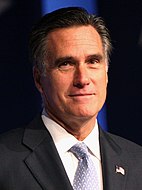Voting in the United States is a two party system. Every president since 1852 has been either a Republican or a Democrat.
In the U.S., a "single-member district system" applies. The candidate who gets elected is the one who gets the highest number of votes in their respective state.
Presidents are elected indirectly. The voters are really voting for electors in each state.
In the U.S., a "single-member district system" applies. The candidate who gets elected is the one who gets the highest number of votes in their respective state.
Presidents are elected indirectly. The voters are really voting for electors in each state.
In all states, the candidate who wins a plurality, receives all of that state's electoral votes. All together there are 538 electors (in the "Electoral College). It is very important to win in populous states.
To win the presidential election, a candidate must earn an absolute majority at least 270 of the 538 electoral votes cast nationwide.
Who can run for President?
He must be a natural-born citizen of the United States, be at least 35 years of age, and have been a resident of the United States for 14 years.
How long is the President in office?
He is in office for 4 years.
Can the President be reelected?
Yes. He can be reelected once. Overall he can be in office for 8 years.
Who can vote?
Anyone who is 18 years of age. There is no national list of eligible voters, so a citizen must first qualify by becoming registered. Citizens register to vote in conjunction with the place they live, if they move to a new location, they typically have to register again. Registration system has been designed to eliminate fraud.
Is the President elected directly?
No. Voters are voting for electors who are members of a party.
When is election day?
Election day is the Tuesday after the first Monday in November.
When is the Inauguration of the President?
The President will be inaugurated on January 20 in the year after the election. From this time he is in office.
What are primaries?
At the primaries the parties nominate their candidates. This takes place about 1 year prior to the election.
There are
- closed / semi-closed primaries (e.g. Arizona)
- open primaries (e.g. Missouri)
- blanket primaries (e.g. Lousiana)
There are
- closed / semi-closed primaries (e.g. Arizona)
- open primaries (e.g. Missouri)
- blanket primaries (e.g. Lousiana)
What are"caucuses"?
In some states (e.g. Iowa) there are three levels.
1st: local
2nd: district
3rd: state
Voters are voting for electors here, too. (e.g. North Dakota)
1st: local
2nd: district
3rd: state
Voters are voting for electors here, too. (e.g. North Dakota)
What is "Super Tuesday"
At this day there are pre-elections in at least 8 states. The winner of the primaries is most likely the candidate for the elections.
Kinds of Voting Technology
Elections in the United States are administered at the state and local level, and the federal government does not set mandatory standards for voting technologies. 1. Paper Ballots
2. Lever Machines
3. Punchcards
4. Computer (push-buttons)
5. Marksense Forms
6. Electronic Voting
2. Lever Machines
3. Punchcards
4. Computer (push-buttons)
5. Marksense Forms
6. Electronic Voting
Electoral College
There is a total of 538 electors. In December the electors meet in each states’s capitol to formally elect the President.
The congress meets in joint session to count the electoral votes January 6.
The congress meets in joint session to count the electoral votes January 6.
Voting pattern in America
The turn out at the election is only 50%. The problem that has made worse the issue of voter representation is the fact that an individual must initiate voter registration well before election day.



Немає коментарів:
Дописати коментар